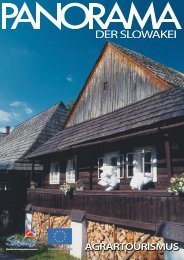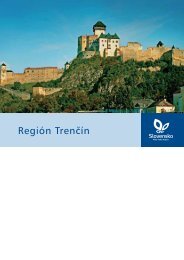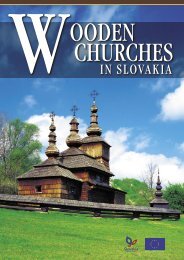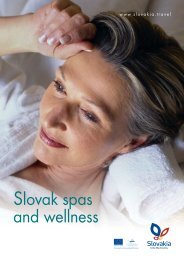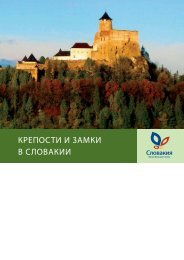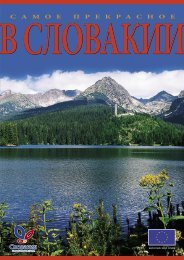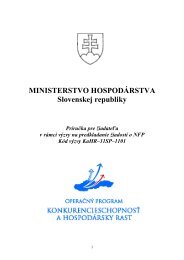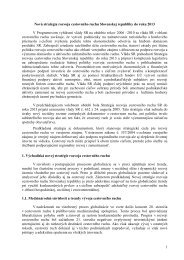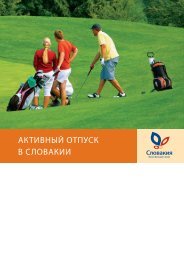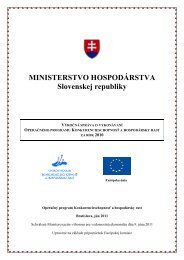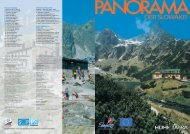You also want an ePaper? Increase the reach of your titles
YUMPU automatically turns print PDFs into web optimized ePapers that Google loves.
The<br />
View of the northern slopes of Ďumbier<br />
superlatives...<br />
The village of Špania Dolina<br />
Demänovská jaskyňa slobody<br />
(Demänová Freedom Cave)<br />
The Chopok sever - Jasná Lúková ski centre<br />
In area, the Low Tatras (Nízke Tatry) form the<br />
largest mountain range in Slovakia<br />
The highest summit in the range is Ďumbier at<br />
2043 metres above sea level<br />
The longest valley is Vajskovská, on the<br />
southern side of the range<br />
The cave with the largest number of visitors is<br />
Demänovská jaskyňa slobody (Demänová<br />
Freedom Cave) in the valley of Demänovská<br />
dolina<br />
70% of the Low Tatra National Park is covered<br />
by forests<br />
and the forest paths along which they transported the ore to the hammer<br />
mills and smelting works. In Špania Dolina we can see the remains of a<br />
water pipe that brought water from beneath Prašivá peak, 15 km away.<br />
It was the opening to the public of a cave, Demänovská jaskyňa, that<br />
attracted the tourist industry to this area. Tourists began to discover the<br />
beauty of the Low Tatra landscape on a large scale only in the second<br />
half of the 20th century, when chair lifts were built on the northern and<br />
southern slopes of Chopok. Two of the largest tourist centres in the<br />
national park — Demänovská dolina — Jasná in the north and<br />
Trangoška-Srdiečko-Kosodrevina in the south — grew up around their<br />
valley stations.<br />
Bratislava<br />
The second most frequented mountain range in Slovakia is the Nízke<br />
Tatry - the Low Tatras. On account of its plentiful forests and rich ore<br />
deposits, this area has attracted interest since times immemorial.<br />
Documents from the period tell us that precious and non-ferrous metals<br />
were already mined here in the Middle Ages. Mining for silver ore in the<br />
11th century uncovered such rich deposits of copper ore that silver lost<br />
its former value. The intensive mining of minerals was concentrated in the<br />
area of the Staré Hory hills, Špania Dolina, Magurka and Dúbrava,<br />
Vyšná Boca and Nižná Boca. Copper, iron, antimony, gold, silver and<br />
lead were the main ores to be extracted. In 1917 a lump of gold<br />
weighing 7.5 kg was found in Magurka, where extremely pure gold<br />
usually occurred in silica veins in the form of tiny grains and strands. All<br />
that is left nowadays to remind us of this glorious mining history are the<br />
characteristic wooden houses of the German miners who settled here<br />
Brankovský vodopád,<br />
a 55-metre waterfall<br />
www.nizketatry.sk<br />
Pages 2–3<br />
THE LOW TATRAS
Kráľova hoľa dominates the eastern part of the Low Tatras<br />
summits<br />
The The Chopok sever - Záhradky ski centre<br />
The Kosodrevina mountain hotel<br />
on the southern slopes of Chopok<br />
The Low Tatra range is a massive mountain arc stretching<br />
through the middle of Slovakia from the west to the east. The main<br />
ridge is almost 100 km long, reaching a height of 1500 - 2000<br />
metres above sea level. Three Low Tatra summits are even higher<br />
than this - Ďumbier (2043m), Štiavnica (2025 m) and Chopok<br />
(2023 m), another 18 summits are over 1800 m and a further 27<br />
more than 1700 metres above sea level. The range is flanked by<br />
valleys and washed by the waters of two substantial rivers, the<br />
Váh and the Hron. To the north the Low Tatras run into a broad<br />
basin, the Podtatranská kotlina, to the south into the Horehronské<br />
podolie. To the west they border on the Veľká Fatra range, to the<br />
east on the karst plateaux of the Slovenský raj ("Slovak<br />
Paradise"). Three quarters of the Low Tatra area are covered by<br />
forests. Lower down these are mixed forest, while firs and dwarf<br />
pines cover the mountainsides, which give way to treeless alpine<br />
summits.<br />
The highest peak in the Low Tatras is Ďumbier (2043 m), a huge<br />
alpine massif that has also given its name to the western part of<br />
the range - the Ďumbierske Tatry. This is the higher and more<br />
rugged part of the Low Tatras, while majestic Kráľova hoľa (1946 m)<br />
is the queen of the eastern part, known as the Kráľovohoľské<br />
Tatry. The border between them is formed by the Čertovica<br />
mountain pass (1238 m).<br />
A number of Low Tatra summits offer splendid, distinctive<br />
panoramic views over the surrounding countryside. All the ranges<br />
of hills and mountains in central and northern Slovakia can be<br />
seen from Ďumbier. It has mountain faces 500 m high and gullies<br />
running into the glacial basins of the Bystrá and Ludárová valleys.<br />
Its gentler southern slopes are covered with large areas of granite<br />
rocks. In the Ďumbier valleys we find sites of now-exhausted<br />
deposits of non-ferrous and precious metals. Battles took place<br />
in 1944 during the Second World War in the saddle between<br />
Ďumbier and Králička and we are reminded of this historical event<br />
by a memorial dedicated to fallen partisans not far from Chata<br />
Milana Rastislava Štefánika, a mountain hut built below the summit<br />
of Ďumbier in 1924 at a height of 1728 m. It provides overnight<br />
accommodation and refreshments 365 days in the year.<br />
The third highest peak in the Low Tatras is Chopok (2024 m). Its<br />
slopes attract downhill skiers in particular, but also offer plenty of<br />
sporting activities in the summer months. It is accessible on the<br />
northern side from Luková, which can be reached by chair lift from<br />
Koliesko chalet in Demänovská dolina valley. On the southern<br />
side it can be approached from Kosodrevina Hotel, which is<br />
served by a chair lift from Bystrá dolina, starting at Srdiečko Hotel.<br />
After a strenuous ascent to the top of Chopok we are rewarded<br />
by a breathtaking view over the surroundings. Refreshments are<br />
offered by Kamenná chata pod Chopkom, a mountain hut open<br />
all year round, where it is possible in emergencies to sleep<br />
overnight in a common dormitory. At a height of 2000 m, it is the<br />
third highest shelter in Slovakia. It can also be reached from<br />
Demänovská dolina, from the upper station of the chair lift to Luková.<br />
Kamenná chata pod Chopkom is ideally situated for mountain<br />
hikes and when crossing the ridge of the Low Tatras. There is also<br />
a meteorological and relay station on Chopok.<br />
Kráľova hoľa (1946 m), often mentioned in legends, myths and<br />
folk songs is, after Chopok, the most frequently visited summit in<br />
the range. If you reach the top, you will have a wonderful view<br />
over the Muránska planina and the Slovenský raj and to the north<br />
you can see the High and Western Tatras. It is a broad, grassy<br />
hill and the highest summit in the eastern, "Kráľovohoľská", part of<br />
the Low Tatras. Its southern slopes are broken up by little valleys,<br />
while the northern side has long, rounded slopes covered with<br />
trees. Like Kriváň in the High Tatras, it is a national symbol of the<br />
Slovaks, which is why hundreds of tourists climb it every year. In<br />
1960 a television transmitter was built on its summit, which also<br />
provides a post for the Low Tatra Mountain Rescue Service.<br />
Nižná Boca below the Čertovica mountain pass<br />
Pages 4–5<br />
THE LOW TATRAS
The starting point from the Kráľova hoľa summit<br />
Climatic<br />
conditions<br />
At the sources of<br />
Slovak rivers<br />
On account of the great differences in altitude, there are as<br />
many as 5 temperature zones within the national park. The<br />
treeless ridges have a harsh climate with average temperatures<br />
of -9°C in January and 7 - 11.5°C in July. The lower mountain<br />
valleys have an average summer temperature of as much as<br />
16°C. From the point of view of winter sports, the slopes that can<br />
be used for the longest period of time are those of Chopok, which<br />
have a covering of snow for up to 130 days in the year.<br />
Avalanches from the steepest slopes of the summits pose a very<br />
serious threat. The snow cover in April and even in May is more<br />
stable and you can experience some fantastic skiing on Chopok<br />
at that time. In summer the weather is very changeable in the Low<br />
Tatras, with frequent local storms, which go as quickly as they<br />
come. For hiking August and September are the most suitable,<br />
when the weather is drier and more settled.<br />
The sporting and tourist activities the slopes and valleys of the Low<br />
Tatras have to offer are primarily downhill and cross-country<br />
skiing, hiking, cycling, mountaineering, rock climbing and<br />
paragliding. The most popular ski resorts are Jasná and Donovaly.<br />
The Low Tatra region provides a vital supply of water. Four<br />
large rivers have their sources on the slopes of Kráľova hoľa<br />
— the Čierny Váh, Hron, Hornád and Hnilec, which is why<br />
the Kráľova hoľa massif is also called "the roof of Slovakia". The<br />
mountain streams, brooks and little rivers actually flow into two<br />
main rivers, the northern slopes of the range being drained by the<br />
longest river in Slovakia, the Váh (403 km) and the southern<br />
slopes by the Hron. In the east, they are helped by the Hnilec.<br />
Near the source of this river a waterfall, Martalúska, cascades<br />
down the Kráľova hoľa hillside. A similar original natural<br />
phenomenon, 30 metres of foaming cascades is to be found in<br />
Vajskovská dolina, one of the longest valleys in the southern<br />
slopes of the Low Tatras. The original technical facilities for<br />
transporting wood down the river have been restored on the<br />
Vajskovský potok.<br />
Many rivers flow underground through the karst landscape, later<br />
surfacing as large springs, especially in the Demänovská and<br />
Jánska valleys. In addition to the sources of drinking water, there<br />
are a number of mineral springs. Health resorts have been<br />
established in Korytnica and Liptovský Ján. Refreshing, pleasanttasting<br />
springs also bubble out of the ground near Moštenice,<br />
Hiadeľ, Jasenie, Mýto pod Ďumbierom, Jarabá, Beňuš, Bacúch,<br />
Liptovská Lúžna, Ludrová, Liptovská Štiavnica, Liptovské Sliače,<br />
Vyšná Boca and Malužiná. In contrast to the High Tatras, the Low<br />
Tatras have few natural lakes. One exception is Vrbické pleso in<br />
Demänovská dolina, which covers 6.2 hectares and lies at an<br />
altitude of 1113 metres above sea level.<br />
Korytnica, a part of Liptovská osada, surrounded by steep hills<br />
with deep coniferous, (mainly spruce) forests, is the highest<br />
located Slovak health resort (825 m). Mineral water<br />
springs from the ground at an altitude of 850 m. The<br />
ferrous, gypseous acidulous mineral water is often compared<br />
to the springs in the Czech town of Karlove Vary and Vichy<br />
in France. In the form of tub baths and drinking cures it<br />
has a positive effect on digestive and metabolic disorders<br />
and disorders of the endocrine glands. Korytnica mineral<br />
water won a gold medal at the World Exhibition as<br />
early as 1873 and in 1904 a silver medal in Saint Louis<br />
in the USA. Korytnica mineral water with its characteristic<br />
taste is bottled to this day and is available in the shops.<br />
The tarn of Vrbické pleso<br />
Pages 6-7<br />
THE LOW TATRAS
In the deep<br />
valleys<br />
Tatralandia Aquapark near Liptovský Mikuláš<br />
Golf at Tále<br />
Paddling down the River Váh<br />
The valley in the Low Tatras which is most often visited is the 15-<br />
kilometre Demänovská dolina. While its lower part is a deep<br />
limestone canyon, the upper part is granite with a number of smaller<br />
valleys. Formerly this was the home of woodcutters, shepherds and<br />
herdsmen, who in the 18th and 19th centuries built sheep farm huts,<br />
shelters and log cabins here. The valley became a tourist attraction<br />
after the discovery of the Demänová Freedom Cave (Demänovská<br />
jaskyňa slobody) and after the building of a chair lift from Jasná to<br />
Chopok. Demänovská dolina is a popular place to go to for tourists<br />
throughout the year. It provides over 2000 beds in hotels, guest<br />
houses and chalets of all categories. In summer the conditions here<br />
are ideal for recreational hiking in the mountains. Marked trails of<br />
varying difficulty run through the valley, their total length on the<br />
northern slopes of the Low Tatras being as much as 515 km.<br />
In the Jasná centre (1102 m) in the upper part of Demänovská<br />
dolina fans of extreme and adrenalin sports can practice<br />
paragliding, climb 20 - 40 m limestone cliffs in the Machnaté<br />
saddle area (1450 m), try out rafting on a 12 km stretch of the River<br />
Váh, or the water slalom course built in Liptovský Mikuláš. Cyclists<br />
can cover almost 140 km on mountain bikes, either around the<br />
Liptovská Mara reservoir, or along hillier terrain on good asphalt<br />
and natural roads through the hills. A horse-riding arena has been<br />
established in Jalovec, 5 km from Liptovský Mikuláš. For skilled riders<br />
it offers steeplechase or individual outings in the countryside and<br />
trips in the saddle up to a height of 2000 metres. For those less<br />
experienced, qualified instructors are available, and that applies to<br />
all branches of sport.<br />
In winter Jasná is one of the most popular winter sports centres in<br />
Slovakia. The downhill skiing conditions here are excellent for<br />
beginner, intermediate and expert skiers alike. Of the 28 km of<br />
tracks for recreational skiing, 18 downhill runs are regularly<br />
maintained, 11 km have snow-making facilities and 1.5 km are<br />
floodlit to make evening skiing possible. The ski slopes have several<br />
runs that meet the criteria for the top sporting events. World and<br />
European Cup competitions have taken place here, as well as<br />
World Winter University competitions. The cross-country trails and<br />
ski mountaineering localities are equally well maintained. The<br />
newly-opened snow park for snowboarders and freestyle skiers in<br />
Otupné is one of the most modern and it has 12 metal obstacles<br />
and a medium jump, a tow and a cabin cableway. In the winter<br />
Záhradky can boast of an ice tower 7.5 metres high. The North Low<br />
Tatra Mountain Rescue Service and mountain guides offer<br />
avalanche courses, rock and mountain climbing schools.<br />
Chopok sever (north) – Záhradky (1025 m)<br />
6 and 2-seater chair lifts, 4 ski tows<br />
Chopok sever – Jasná Luková (1234 m)<br />
4-seater chair lift, 2 ski tows<br />
Chopok sever – Otupné (1142 m)<br />
1 cabin cableway, 4-seater chair lift, 5 ski tows<br />
Chopok sever – Luková (1670 m)<br />
2-seater chair lift, 1 ski tow<br />
In the karst hollow of Jánska dolina lies the spa village of Liptovský<br />
Ján (634 m), which written records mention as early as the 13th<br />
century. The focal point of the village is the Gothic church of St. John<br />
the Baptist from 1380 and over 20 yeomen's mansions and manor<br />
houses have been preserved, as well as a number of log cottages.<br />
For visitors there are hotels, guest houses and leisure facilities. Since<br />
2000 Liptovský Ján has been classified as one of Slovakia's climatic<br />
spas. However, its thermal gypseous, sulphurous, carbonic mineral<br />
springs were used much earlier for the treatment of nervous,<br />
rheumatic and women's disorders. Contemporary studies have<br />
confirmed the curative effects of another two bore holes, which are<br />
used to supply the indoor pool in the Máj leisure centre and the<br />
• Mountain Rescue Service headquarters (Poprad)<br />
Tel.: 00421/18300 (from all telecommunication networks)<br />
• Demänovská dolina Mountain Rescue Service (Jasná)<br />
Horská záchranná služba<br />
Tel.: 00421/44/5591678<br />
thermal pool at the edge of the forest above the village with<br />
its swimming and children's pools. It is clear that there is an<br />
abundance of underground curative springs in the area<br />
when we consider that only a few kilometres from Liptovský<br />
Ján there are three of the most modern aquaparks in<br />
Slovakia - Termálpark Bešeňová, Aquacity Poprad and<br />
Tatralandia Liptovský Mikuláš, which can remain open<br />
throughout the year thanks to their hot thermal waters.<br />
Other localities equally suitable for hikers, cyclists or<br />
motorists no doubt help to make the holidaymakers' stay<br />
a pleasant one. In the village of Vlkolínec not far from<br />
Ružomberok a unique group of almost 40 log cottages<br />
have survived to this day. In 1993 Vlkolínec heritage<br />
reserve was included on the UNESCO List of World<br />
Cultural and Natural Heritage. The construction of a<br />
dam 45 m high on the River Váh formed a 21.6 km 2<br />
artificial lake known as Liptovská Mara, with eight Liptov<br />
villages disappearing below its surface. Many of the log<br />
cottages and the more valued buildings were dismantled<br />
and re-erected in the Museum of the Liptov Village in<br />
nearby Pribylina. An exceptional Lutheran wooden<br />
church from 1774, built in the now submerged village of<br />
Paludza to meet stringent Counter-Reformation<br />
regulations (e.g. no nails) for a congregation of 5000,<br />
was transferred to the village of Svätý Kríž, where it once<br />
again serves its original purpose. The open-air<br />
archeological museum in Havránok (near Liptovská<br />
Mara) is a reconstruction of original Celtic buildings and<br />
a small medieval castle. On your way eastwards, in the<br />
midst of the Tatra national parks, you can stop in the little<br />
town of Liptovský Hrádok, which was mentioned in the<br />
annals as having the first forestry school in the former<br />
Hungarian kingdom (1796). The pride of the town is<br />
also a protected alley of linden trees 200 years old and<br />
www.jasna.sk<br />
www.tatralandia.sk<br />
www.aquacity.sk<br />
www.besenova.sk<br />
Pages 8–9<br />
THE LOW TATRAS
The upper station of the chair lift to Nová hoľa<br />
The World Sled Dog Race Championships at Donovaly<br />
Racing on old-fashioned sledges<br />
in the village of Turecká<br />
the Hrádok arboretum with 719 species of rare trees and shrubs.<br />
Summer visitors to Slovakia should also not miss the folklore<br />
festival held on the first weekend of August at the foot of Kráľova<br />
hoľa in the distinctive village of Liptovská Teplička (919 m). Its<br />
interesting features include cellars dug in the hillsides for storing<br />
potatoes and the thin strips of fields and meadows that lend<br />
colour to the surroundings of the village.<br />
Of the southern valleys in the Low Tatras, Bystrá dolina is the best<br />
known to tourists. A trip to this valley starts in the mountain village<br />
of Bystrá. Originally a mining village, it now attracts<br />
holidaymakers. From here we can get to the cave of Bystrianska<br />
jaskyňa, as well as to the popular tourist centre of Tále and Bystrá<br />
dolina. Tále (700 m) took its name from the wide belts of<br />
meadows stretching above it. Its geographical position is suitable<br />
for both summer and winter sports. In its vicinity there is an 18-<br />
hole golf course, tennis courts, a horse and pony farm and a<br />
summer swimming pool. From Tále there is an excellent hike to the<br />
top of Chopok and Ďumbier from Trangoška mountain hut (1120 m),<br />
or Srdiečko mountain hotel (1216 m), lying at the end of Bystrá<br />
dolina beside the valley station of the chair lift to Chopok. On this<br />
route, near the top station of the Srdiečko - Kosodrevina chair lift,<br />
we can visit the seasonal mountain hotel Kosodrevina (1500 m).<br />
An easy tour from Tále to the west takes us to a natural lake and<br />
the recreational village of Krpáčovo (730 m).<br />
Tále ski centre (700 m) – 5 ski tows<br />
Chopok (south) - Kosodrevina (1489 m) – 3 ski tows<br />
Chopok - Srdiečko (1216 m) – 1 chair lift, 1 ski tow<br />
Only 5 km from Tále there is another winter sports centre at the<br />
mountain village of Mýto pod Ďumbierom. It is situated at an<br />
altitude of 630 m, and hiking trails lead from here into the valley<br />
of Mlynná dolina.<br />
5 ski tows, night skiing, artificial snow, ski and snowboard<br />
hire, a ski school<br />
The Ďumbier and Kráľova hoľa parts of the Low Tatras are divided from<br />
each other by the Čertovica mountain pass. This connects the Horehronie<br />
and Liptov regions. At the end of Bocianska dolina below Čertovica we<br />
find Vyšná Boca (951 m) and Nižná Boca (851 m), former mining villages<br />
where at one time there were rich deposits of iron, gold and antimony.<br />
When the deposits were exhausted, forestry, cattle breeding and felt<br />
making became the population's main source of livelihood. Only the timber<br />
miners' houses with balconies running along one side, which now serve the<br />
D<br />
tourist ruh×m industry, najnav‰etvovanej‰ím are left to remind us of the pohorím villages' former Slovenska prosperity. sú Nízke In the<br />
Čertovica Tatry. saddle Svojím there bohatstvom is a mountain lesov chalet a ‰tedr×mi of the same náleziskami name (1238 rúd m)<br />
that boli provides odpradávna accommodation vyhşadávanou and refreshments. oblasČou. ZThe dobov×ch grassy northern správ<br />
slopes vieme, of Ďe Bocianska uĎ v stredoveku dolina offer tu excellent dob×vali conditions drahé for askiing.<br />
farebné kovy.<br />
• Mountain Rescue Service (Tále centre)<br />
Tel.: 00421/48/6170038, 00421/903/624078<br />
• Mountain Rescue Service (Donovaly centre)<br />
Tel.: 00421/48/4199724, 00421/903/624049<br />
VThe XI. valley storoăí of Starohorská pri ČaĎbe striebornej dolina also rudy falls within sa odkryli the administrative také bohaté<br />
loĎiská district of medenej the Low Tatra rudy, National Ďe striebro Park, even stratilo though svoju it lies hodnotu. on the<br />
Intenzívna border between ČaĎba the nerastn×ch Low Tatras surovín and the sa sústreěovala Veľká Fatra mountains. do oblastí<br />
Star×ch Along its Hôr route, a ·panej from Banská Doliny, Bystrica v Magurke over athe Dúbrave, Donovaly vo mountain Vy‰nej<br />
apass NiĎnej to Ružomberok, Boci. ËaĎili najmä there meě, runs Ďelezo, an interesting antimón, road zlato, through striebro<br />
attractive olovo. Vnatural Magurke, scenery kde and sa vysoko traditional r×dze mountain zlato v villages. kremenn×ch The<br />
Ďilách heritage nachádzalo reserve of Špania v podobe Dolina drobn×ch (710 m) zrniek offers ainteresting drôtikov, na‰li relics<br />
vfrom roku its 1917 mining aj past zlatú and hrudu has váĎiacu made a 7,5 name kg. for Slávnu itself banícku with its<br />
minulosČ exceptional pripomínajú lace-making uĎ tradition. len charakteristické Staré Hory drevené (470 m) domy is a<br />
nemeck×ch village visited baníckych by pilgrims; kolonistov it has a well lesné dedicated cesty, po to ktor×ch the Virgin sa<br />
zváĎala Mary and ruda an do original hámrov Gothic a hút. church, V ·panej which doline was sa granted zachovali the<br />
pozostatky status of "Basilica vodovodu, minor" ktor× by the sem Pope spod in vrchu 1990. Pra‰ivej, From here z a 15 road km<br />
vzdialenosti leads to Turecká privádzal - Krížna samospádom ski centre vodu. with its 4 ski tows and<br />
Záujem downhill cestovného tracks covering ruchu 2500 o túto metres oblasČ with artificial súvisel snowmaking<br />
objavením<br />
afacilities. sprístupnením The village Demänovsk×ch of Turecká (610 jask×Ŕ. m) regularly Krásy nízkotatranskej<br />
holds unusual<br />
prírody races on zaăali traditional v masovej‰om Slovak sledges meradle and the objavovaČ world championships turisti aĎ<br />
vin druhej cooking polovici and 20. eating storoăia, the national kedy sa pasta vybudovala dish with lanovka sheep's zo<br />
cheese, bryndzové halušky. At an altitude of 960 m lies<br />
the 300-year old mountain village of Donovaly, which<br />
has become an exceptionally popular tourist centre for<br />
recreation and sport. For more skilful skiers the slopes<br />
below Nová hoľa (1370 m) offer 2 km of downhill runs<br />
with a six-seater chair lift and 2 ski tows, while the<br />
Záhradište area is ideal for families, with its four-seater<br />
chair lift, 11 ski tows, snowboarding obstacles and 25<br />
km of maintained tracks for cross-country skiers. In<br />
1999 this was the venue for the World Sled Dog Race<br />
Championships and on several occasions the European<br />
championships have been held here. The gentle terrain<br />
around Donovaly is suitable for family hiking trips and<br />
cycling and the top of Nová hoľa is the starting point to<br />
the surrounding slopes for ski mountaineers and<br />
paraglider pilots. Cosy hotels, guest houses, apartment<br />
rooms with all services, restaurants with a selection of<br />
Slovak and international specialities, swimming pools,<br />
fitness centres, saunas and massage will please even the<br />
most exacting visitors.<br />
www.parksnow.sk/donovaly<br />
Pages 10-11<br />
THE LOW TATRAS
Stalactite decorations in Demänovská jaskyňa slobody<br />
An enchanting world<br />
underground<br />
Speleotherapy in Bystrianska jaskyňa<br />
Ice formations in Demänovská ľadová jaskyňa<br />
Over thousands of years the rushing waters of the Low Tatras<br />
carved out and shaped the enchanting underground world<br />
that we can admire today in the caves that have been made accessible.<br />
The most important area is the Demänová karst region in the north of<br />
the range, where cavers discovered a huge and intricate cave system<br />
with over 170 caves formed by rivers in Demänovská dolina. The longest<br />
cave system with nine levels and a 173 m elevation difference measures<br />
30 km. It is made up of nine interconnected Demänová caves, of which<br />
two, Demänovská jaskyňa slobody (Demänová Freedom Cave)<br />
and Demänovská ľadová jaskyňa (Demänová Ice Cave) are also open<br />
to the public. Demänovská jaskyňa slobody with its large sinter waterfalls<br />
and columns, unique sinter water lilies and other bizarre lake formations<br />
is one of the most beautiful of its kind in Europe. In many places its<br />
passages, which measure 8126 m, widen out into spaces reminiscent<br />
of halls and domes. The largest of them is known as Veľký dóm (The<br />
Great Dome), which has magnificent sinter decorations. The two<br />
possible sightseeing routes, approximately 1200 and 1800 metres<br />
long, pass the riverbed of the Demänovka stream and the cave<br />
lakes. The cave was discovered in 1921 and in 1933 it was made<br />
accessible to visitors. The constant temperature of around 7°C and<br />
the relatively high humidity also make it suitable for therapeutic<br />
purposes in the treatment of respiratory diseases and allergies.<br />
People knew of the existence of the ice cave Demänovská ľadová<br />
jaskyňa even in the Middle Ages, although the first written mention<br />
dates back to 1719. As in other caves in Slovakia, the remains of<br />
bones of vertebrates and cave bears can still be seen. The ice<br />
columns and waterfalls were formed 400 years ago. In 1880, and<br />
again in 1950 a 650 m stretch was opened to the public.<br />
In the Važec karst region, on the western edge of the village of the<br />
same name, it is possible to see another cave, Važecká jaskyňa. It<br />
was discovered in 1922, opened to the public in 1934 and<br />
reconstructed twenty years later. Its 530 metre-long underground<br />
spaces are an important paleontological site. The present<br />
sightseeing route covers a 235-metre section.<br />
On the fringe of the village of Bystrá on the southern side of the Low<br />
Tatras, a cave known as Bystrianska jaskyňa was discovered in<br />
1923. It runs through the Bystrianske podhorie foothills for a length<br />
of 1000 m, of which 490 metres have been open to visitors since<br />
1968. It has interesting curtain-like sinter decorations and in places<br />
aragonite is to be found.<br />
Many caves have been open for decades, but there is growing<br />
interest in little-known, newly discovered caves not generally<br />
accessible. They attract those with a taste for adrenalin sports. One<br />
such cave is the fascinating Jaskyňa mŕtvych netopierov (Cave of<br />
Dead Bats), discovered in 1981 in the alpine karst of the Kozie<br />
chrbty hills. Its entrance is to be found near the marked hiking trail<br />
between Trangoška and Chata M.R.Štefánika. The cave was given<br />
its name on account of the bones of the bats that lived here in large<br />
numbers. It has 14 km of passages, a section of which can be<br />
viewed in the company of a speleological guide, who provides<br />
visitors with special overalls, helmets and torches.<br />
You can learn more about the caves in Slovakia if you pay a visit to<br />
the Slovak Museum of Wildlife Conservation and Caving in Liptovský<br />
Mikuláš.<br />
Demänovská ľadová jaskyna - Demänová Ice Cave<br />
www.smopaj.sk<br />
Pages 12-13<br />
THE LOW TATRAS
The Low Tatra<br />
National Park<br />
The summit of Rovná hoľa (1723 m) is easily<br />
reached from the saddle Bocianske sedlo<br />
NAPANT<br />
The first attempts to provide overall protection for the Low<br />
Tatras date back to 1918 - 1921, but they took on a<br />
definite form only after 1963. An area of 81 095 hectares in<br />
the Low Tatra mountains was actually declared a national park<br />
(NAPANT) as late as 1978 and 123 990 hectares around it<br />
were registered as a protection zone. Almost twenty years later<br />
the borders of the national park were revised. It now covers<br />
72 842 hectares, with a protection zone of 110 162 hectares.<br />
Of Slovakia's nine national parks, this is the largest one. Within<br />
NAPANT there are 10 national nature reserves, 12 nature<br />
reserves, 3 protected grounds, 2 national natural heritage sites<br />
and 6 natural heritage sites. Systematic activities are organised<br />
here for the protection of the landscape, flora and fauna, for the<br />
special protection of minerals, fossils and trees. The<br />
administration offices of NAPANT are in Banská Bystrica.<br />
It was not by chance that the brown bear (Ursus arctos)<br />
appears in the national park's emblem. The symbol itself<br />
suggests that this, the largest predator, is to be found in its<br />
territory. In recent years its numbers have grown rapidly and<br />
the shy bear has become a regular visitor to human dwellings.<br />
Nowadays, it is no rarity to come across a family of bears on<br />
a walk through the countryside or in the vicinity of mountain<br />
villages, where it is very fond of rummaging through the<br />
dustbins and tasting the fruit growing on the trees in the<br />
orchards. In the forests and alpine zones the fauna includes<br />
chamoix, wolves, lynx and other small predators, as well as<br />
large numbers of red and roe deer and wild boars. It is a<br />
fascinating experience to watch the majestic flight of an eagle<br />
or other birds of prey, to listen to the strange calls of the<br />
capercaillie and the song of the Ring Ouzel (Turdus<br />
torguatus), the Three-toed Woodpecker (Picoides tridactylus)<br />
and the Alpine Accentor (Prunella collaris).<br />
On the granite mountain ridges the harbinger of spring is the<br />
White Pasque Flower [Pulsatilla alba], but the attractive Edelweiss<br />
[Leontopodium alpinum], Spotted Gentian [Gentiana punctata]<br />
and other flowers grow here. On the valley hillsides and in lower<br />
meadows we can find healing plants and at the edge of the forest<br />
wild strawberries, raspberries, bilberries, blackberries and of<br />
course several species of tasty edible mushrooms.<br />
If you visit the Low Tatras in any season of the year, you will be<br />
welcomed by lovely, unspoiled countryside, fresh air and a wide<br />
range of opportunities for sporting and leisure activities, as well as<br />
for getting to know the beautiful natural sights, the abundance of<br />
cultural and historical monuments, and living folklore and as a<br />
bonus to your satisfaction, also good food and peaceful sleep.<br />
No doubt you will soon want to repeat the unforgettable<br />
experiences that you will take away from a visit to Slovakia.<br />
The Low Tatras can be reached along good quality first and<br />
second-class roads as well as by rail. Sections of third-class<br />
roads lead to villages off the main routes and through some of the<br />
nature reserves. There are two airports open all year round in the<br />
close vicinity of the mountain range — Sliač near Banská Bystrica<br />
and to the north east Poprad - Tatry.<br />
The Vajskovský vodopád waterfall<br />
www.nizketatry.sk, www.airports.sk, www.airportsliac.sk<br />
Pages 14-15<br />
THE LOW TATRAS
Slovak Tourist Board offices abroad:<br />
Slovenská agentura pro cestovní ruch<br />
Jilská 16, 110 00 Praha 1, Česká republika<br />
Tel.: +420 2 249 46 082, Fax: +420 2 249 46 082<br />
e-mail: sacrpraha@seznam.cz<br />
Narodowe Centrum Turystyki Slowackiej<br />
ul. Krakowskie Przedmiescie 13 pok.17<br />
00-071 Warszawa, Polska<br />
Tel.: +48 22 827 00 09, Fax: +48 22 827 00 09<br />
e-mail: sacr@poczta.onet.pl<br />
Slowaaks Verkeersbureau<br />
WTC Amsterdam, Strawinskylaan 623<br />
1077 XX Amsterdam, Nederland<br />
Tel.: +31 20 575 2181, Fax: +31 20 575 2182<br />
e-mail: info@slowaaks-verkeersbureau.nl<br />
www.slowaaks-verkeersbureau.nl<br />
<br />
<br />
. 17/19, 123 056 <br />
.: 007 095 251 76 31, : 007 095 251 76 45<br />
e-mail: sacrmow@comail.ru<br />
Slovakische Zentrale für Tourismus<br />
Prinz-Eugen-Str. 70, Stiege 2, 1.Stock<br />
1040 Wien, Österreich<br />
Tel.: +43 1 513 9569, Fax: +43 1 513 9763<br />
e-mail: sacr-wien@aon.at<br />
Slowakische Zentrale für Tourismus<br />
Vertretung Deutschland<br />
Zimmerstrasse 27, 10969 Berlin, Deutschland<br />
Tel.: +49 30 25 94 26 40, Fax: +49 30 25 94 26 41<br />
e-mail: sacr-berlin@botschaft-slowakei.de<br />
e-mail: tourismus@botschaft-slowakei.de<br />
Ministry of Economy SR<br />
Governing body for the Sector Operational Programme<br />
Industry and Services<br />
Mierová 19<br />
827 15 Bratislava<br />
Slovenská republika<br />
e-mail: soper@economy.gov.sk<br />
www.economy.gov.sk<br />
© Slovak Tourist Board<br />
Slovenská agentúra pre cestovný ruch<br />
Nám. Ľ. Štúra 1, P.O.Box 35<br />
974 05 Banská Bystrica, Slovenská republika<br />
Tel: +421 48 413 61 46, Fax: +421 48 413 61 49<br />
e-mail: sacr@sacr.sk, www.slovakiatourism.sk<br />
Branch office Bratislava<br />
Záhradnícka 153, P.O. Box 97<br />
820 05 Bratislava 25, Slovenská republika<br />
Tel: +421 2 507 00 801, Fax: +421 2 555 71 649<br />
e-mail: sacrba@sacr.sk, www.slovakiatourism.sk<br />
Regional office<br />
Reimannova 9<br />
080 01 Prešov<br />
Tel./fax: +421 51 756 03 61<br />
e-mail: presov@sacr.sk, www.slovakiatourism.sk<br />
Editorial board:<br />
Silvia Kolláriková (chairperson)<br />
Kamila Hanáková<br />
Daniel Kollár<br />
Viera Dvořáková<br />
Gabriela Užovičová<br />
Robert Bunča<br />
Editor -in-chief:<br />
Bedrich Schreiber<br />
Photographs:<br />
M. Barlok, BoArt, K. Demuth, M. Eliáš, A. Jiroušek,<br />
L. Khandl, Z. Vlach, A. Vojček<br />
Graphic layout and publishing:<br />
REMARK/CMA s.r.o.<br />
Rozmarínová 31, 821 04 Bratislava<br />
Tel.: +421 2 434 153 60-62, Fax: +421 2 434 153 59<br />
www.remark.sk<br />
English translation:<br />
Heather Trebatická<br />
Published with the support of the European Union



